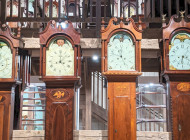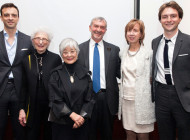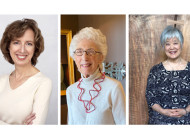By W.A. Demers
MYSTIC, CONN. – When my desk phone rang on a recent afternoon, I picked up the receiver to hear a familiar voice ask, “Are you ready?” I wasn’t – having lost track of time on the conveyor belt of editing duties at Antiques and The Arts Weekly. It was 4:05 pm, five minutes past the time I had arranged to call the paper’s editor at large, Laura Beach, at her home office in Mystic.
Laura was just back from Orlando, Fla., where she and her spouse Josh Kalkstein had spent valuable family time visiting their son Trevor, his wife Elyssa and three grands, Bella, 3, Moses, 5, and Aaron, 8. After Josh and Trevor repaired to the nearby golf course, the family set off for Orlando’s famed attractions, a venture culminating in a birthday dinner for Moses at Disney’s T-Rex Café. Her measured response when I asked how she had enjoyed the frenetic merriment of Spring Break in Orlando was emblematic of the tact, poise and humor that has endeared her to colleagues, academics, dealers and museum curators over the past 30 or so years. Coupled with a grounded sense of professionalism and a passion for arts journalism, these traits make her a natural to be named the 2019 recipient of the Antiques Dealers’ Association of America’s (ADA) Award of Merit, to be presented by the ADA at a dinner at the Philadelphia Antiques and Art Show on Friday, April 26.
For Laura, the award and recognition are a culmination of her lucky encounter with journalism. “I’ve lived by the conviction that if you do what you love, the rest will follow,” she observes. “As an older and wiser person, it’s not advice I would necessarily give others, but in my case, it was true. I’ve been blessed to make a career among extraordinary people in what many consider a rarified environment.”
So what was her path to this Cracker Jack prize? It wasn’t necessarily a beeline. But there was foreshadowing at a young age. Her mother, now retired, was a journalist; in fact, the outstanding journalism graduate of her year at the University of Kansas and later a copywriter at Hallmark in her home of Kansas City. Laura recalls spending many a deadline night with her younger sister playing with hot wax during the years her mother was a society editor at the Los Alamos Monitor. Hold that hot wax reference for later.
A favorite childhood picture, taken July 1965, shows Laura with her sister, Lisa, and her father, Don H. Byers, a physicist at Los Alamos National Laboratory, looking on as she focuses a new camera she has just acquired.
Fast forward to the mid-1970s and Laura, applying on a whim, not having visited, got into Yale University. “A friend and I caught Amtrak in Lamy, N.M., and rode it all the way to New Haven, where I arrived not knowing the first thing about rain, raincoats, umbrellas, preppies, the Establishment or anything else, really,” she recalls.
A stint on the editorial board of the Yale Daily News gave her thoughts about pursuing journalism professionally, but she fell into art history instead, loving all of her art history courses but not having a specialty in mind to pursue – only that she wanted to work in a museum or gallery, or be a professor of art history. It was Charles F. Montgomery, the former Connecticut pewter dealer who became director of Winterthur before leaving for Yale, and while there taught a class on American decorative arts – nicknamed “Pots and Pans” – who set the hooks into the young undergrad by inviting her to organize, as her senior thesis, the exhibition “‘Til Death Do Us Part: Design Sources of Eighteenth Century New England Tombstones,” which was accompanied by a catalog of the same name. Philadelphia-area collector Robert L. McNeil Jr funded the project.
There are many prominent influencers that had a profound impact on Laura, including folk art specialist and museum director Robert Bishop, who was a mentor to her when she landed a job as exhibition coordinator at the Museum of American Folk Art, and Yvonne Lange, a gruff but brilliant director at the Museum of International Folk Art in New Mexico, who granted Laura a summer internship and impressed her by leading by example. In her orbit at Yale were Patricia E. Kane, Margaretta Lovell, Oswaldo Rodriguez Roque, Robert Trent, Kevin Stayton, Ulysses Dietz and Ned Cooke.
She took a silver symposium in her senior year at Yale with Gerald W.R. Ward, later curator of American decorative arts at the Museum of Fine Arts, Boston. At the Museum of American Folk Art, she met Helaine and Burton Fendelman, Nancy Druckman, Lucy and Mike Danziger, Bert Hemphill, Barbara Johnson, Alice Kaplan, Leo and Dorothy Rabkin, Ellie Cullman, Marna Anderson, Adele Earnest, Mary Black, Ralph Esmerian and Susan Flamm, who became the museum’s first fulltime staff publicist.
It is R. Scudder Smith, publisher of Antiques and The Arts Weekly, however, who Laura credits with “introducing me to a world that, were it not for him, I might never have known existed.”
Laura recalls meeting Scudder for the first time in the fall of 1978, not long after she had started as exhibition coordinator at the Museum of American Folk Art. “I was returning objects from the exhibition ‘The All-American Dog: Man’s Best Friend in Folk Art.’ Scudder came to the museum’s 53rd Street offices and gallery to pick up ‘Spike,’ a wonderful shaped canvas portrait of a dog.”
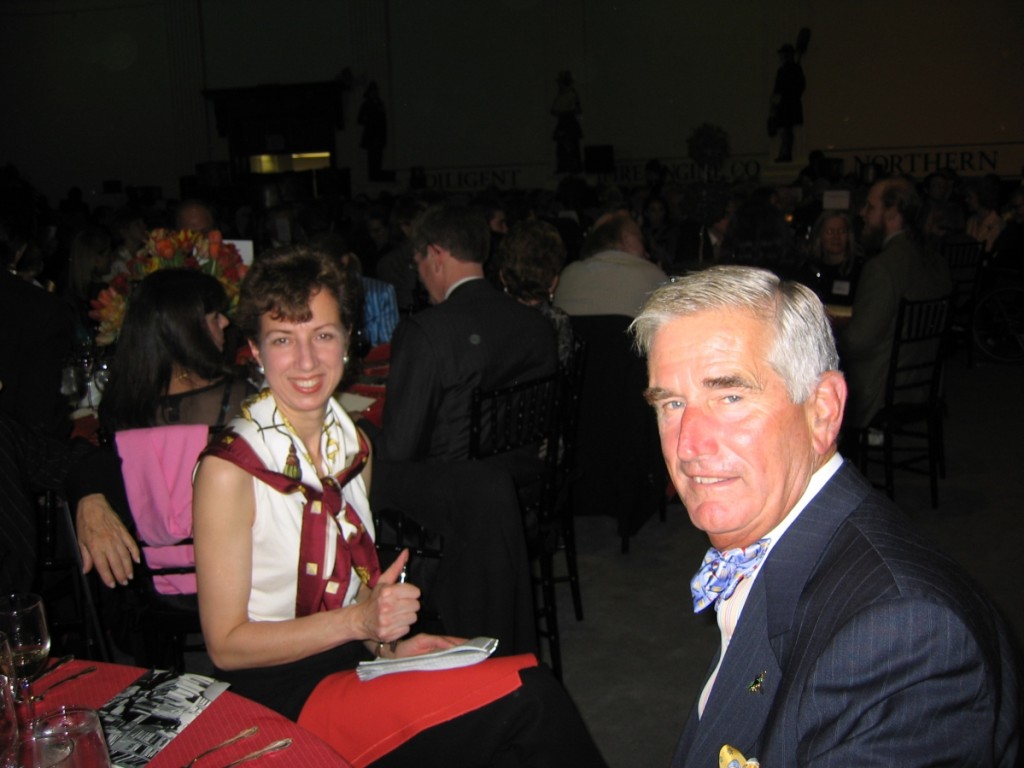
With notepad and pen in hand, Beach and R. Scudder Smith at the ADA Award of Merit dinner honoring Wendell Garrett in 2004.
Eight years later, their paths crossed again when Laura answered an ad seeking an associate editor for Antiques and The Arts Weekly, whose genesis dates to 1963. “I drove to Newtown and parked in the lot adjacent to the red-clapboard building on Church Hill Road that has been Bee Publishing Company’s home since 1903,” she recalls. “Entering through a side door, I was lost in a warren of the most extraordinary offices I’d ever seen. Trade signs, weathervanes, carousel figures and arcade devices mingled in distracting profusion with the Rotary Club trophies and Press Association awards that are to newspapers what diplomas are to dental suites. Great drifts of paper – releases to be edited, proofs to be corrected, letters to be answered – welled up in Scudder’s office.”
The conversation was amiable and Scudder disarmingly casual, recalls Laura. “Before I left, he asked when I could start.”
She jumped into the paper at a time when the antiques business was booming. In 1986, it was a very heady, sometimes frothy time, with lots of important shows and landmark auctions. In January of that year, Christie’s sold a Philadelphia tea table for more than $1 million, a record that was soon surpassed.
Antiques and The Arts Weekly was routinely 200 pages a week and surged to more than 300 pages during high season. Scudder and Laura handled most of the editorial. Returning to that hot wax rumpus described earlier, it was at this time that Laura got her in-house nickname “Fingers,” as she was reportedly so hands-on that she would invade the production room, adjusting copy and photos, which at the time were wax-coated so they could be pasted up on board and photographed to make the printing plates. After a while, she had an assistant. “I went everywhere, did everything and met all. My circle of contacts and access to them, critical in journalism, grew exponentially,” she says.
Scudder and his wife, Helen Smith, were very close to many of the top show promoters, especially Russell Carrell, Fran Phipps, Betty Forbes and Linda Turner, Bill Walter, and Diane and Meg Wendy. Says Laura, “We regularly went out to dinner with these people and knew the dealers who did their shows well.”
Among the many people Scudder and Helen introduced Laura to were Bill Guthman and Penny Stillinger, a husband and wife who, in Laura’s words “showed me how to live a life in antiques with style and meaning.” Bill Guthman was a consummate dealer and dedicated scholar of historical Americana, and with her landmark book The Antiquers (Knopf, 1980), Penny Stillinger, a historian who began her career as an editor at The Magazine Antiques in the 1960s, established a framework for studying the history of collecting American antiques that subsequent scholars have built upon. She added to her extensive body of work with A Kind of Archaeology: Collecting American Folk Art, 1876-1976 (University of Massachusetts Press, 2011), which looks at a later Twentieth Century collecting phenomenon. “Penny has been a wonderful friend and mentor to me,” says Laura, “deeply informed and always generous with her time, knowledge and friendship.”
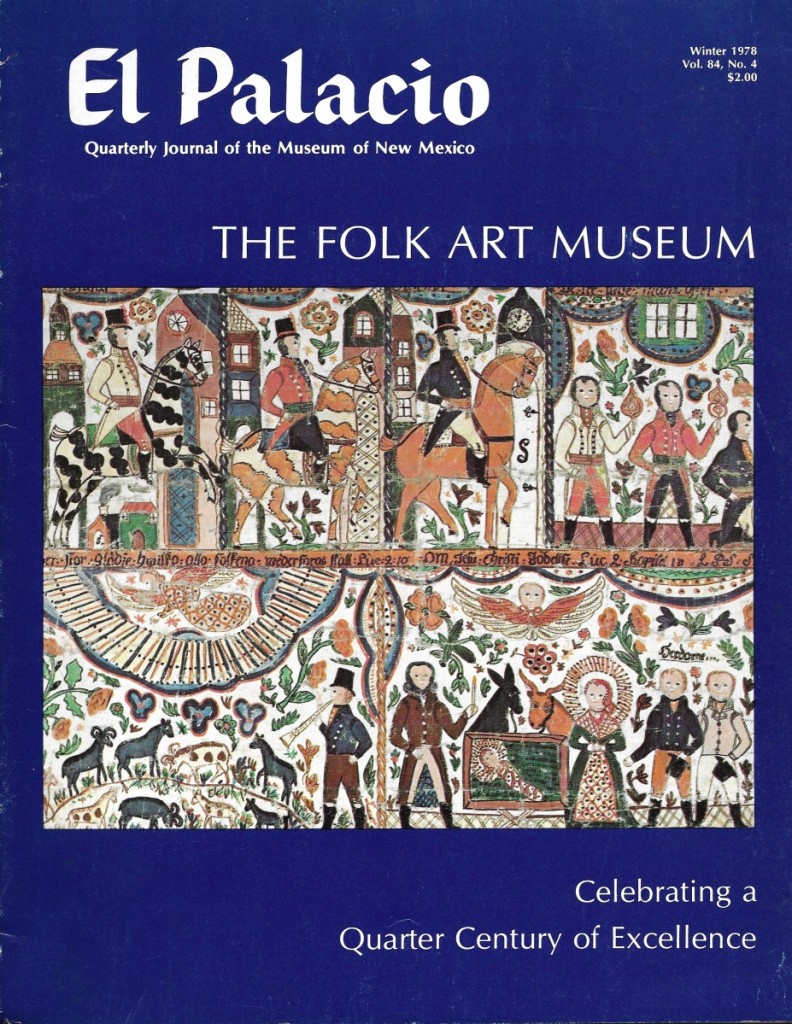
Beach wrote about the collections of the Museum of International Folk Art, a division of the Museum of New Mexico. The piece was published in the Winter 1978 issue of El Palacio magazine. She had already done some things for the Yale Daily News, but this was her first arts piece.
What’s next for the intrepid editor at large who no longer needs to make a daily trek into the office? “We’re jazzed about a trip to the Azores we are taking in June,” said Laura, who with spouse Josh enjoys making regular trips to New Mexico, where her mother still lives. Early in his career, Josh’s legal work took him to Halifax, Nova Scotia, and he became a fan of the Canadian Maritime provinces. Now he and Laura enjoy escaping to the summer house they built there in 1999. “Spending time in Prince Edward Island has introduced us to the quietly distinctive Atlantic Canadian culture,” she said. “We’ve enjoyed learning about its artists and craftspeople, past and present.”
Reflecting on the upcoming ADA award, she muses, “I regard the ADA Award of Merit as a great honor and a great kindness. I really have made my whole life among antiques dealers, I have lived through them in some respects, have learned to see how they see, to prize what they prize. They are my friends and my work family. I enjoy their company and look forward to being with them.
“The ADA Award of Merit dinner is one of the few times a year we come together to celebrate the values we cherish and work so hard to promote.”
She is also reveling in the celebrity. “In January, after the announcement was in the magazines, I was stopped in an elevator at the Metropolitan Museum of Art. A woman said, ‘Oh, you’re Laura Beach. You’re getting the award!'”
That celebrity is very well deserved, according to one of Laura’s biggest fans, Scudder Smith.
“Upon hearing that Laura had been chosen as the recipient of this year’s ADA Award of Merit, Helen and I agreed that the honor had been highly well placed,” said Scudder. “Laura’s beginnings in the field of art and antiques were through museums where she exhibited a natural talent and was able to hold her own and touch elbows with many of the foremost personages of the arts and antiques world. But it was when she walked into our little red building for the second time as a newly hired employee, sat down and went to work as a journalist, that her true talents really blossomed. She had all the attributes necessary: being a great writer, having an inquisitive mind, knowing all the people important to work with, loving to travel and without being offensive was always able to ask just the right questions.
“Working at the fast pace required in the newsprint world with deadlines always lurking over your head, somehow time passes quickly without the realization that you have moved through a decade or two without stopping to appreciate the value of time well spent. Well, of late I have been physically forced to stop my hectic routines and have had that dreamy time to ponder upon the past. And one of the foremost things that came to mind was just what an asset Laura has been to me and this paper for the last 33 years. She truly helped to make Antiques and The Arts Weekly the great paper it became over those years. I will always be greatly indebted to her for her services, always ready to go when and where needed at the drop of hat. I thank you, Laura, and am so proud that you are being recognized by the ADA.”
ADA Dinner Tickets
The ADA Award of Merit dinner honoring Laura R. Beach is planned for Friday, April 26, at 8 pm, at the Philadelphia Antiques and Art Show at the Navy Yard, 11th Street and Kittyhawk Avenue in Philadelphia. Penny Stillinger, writer, lecturer on the American decorative arts, collectors and collecting, will be the guest speaker. Tickets may be purchased online at www.adadealers.com, or send a check for $95 each to the ADA, PO Box 218, Northwood NH 03261. The ticket price includes parking. For information, contact ADA executive director Judith Livingston Loto at 603-942-6498 or email info@adadealers.com.







.jpg)












